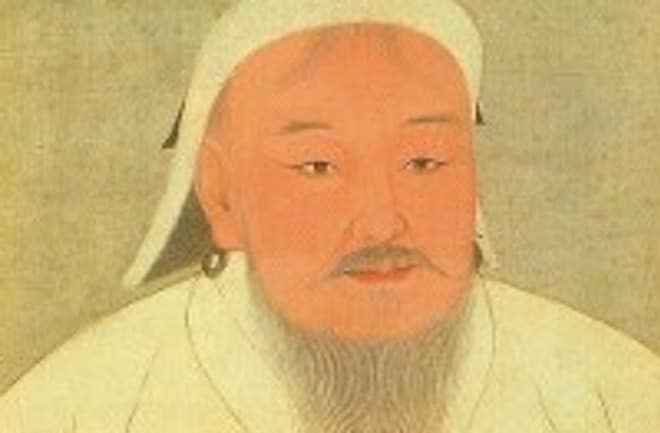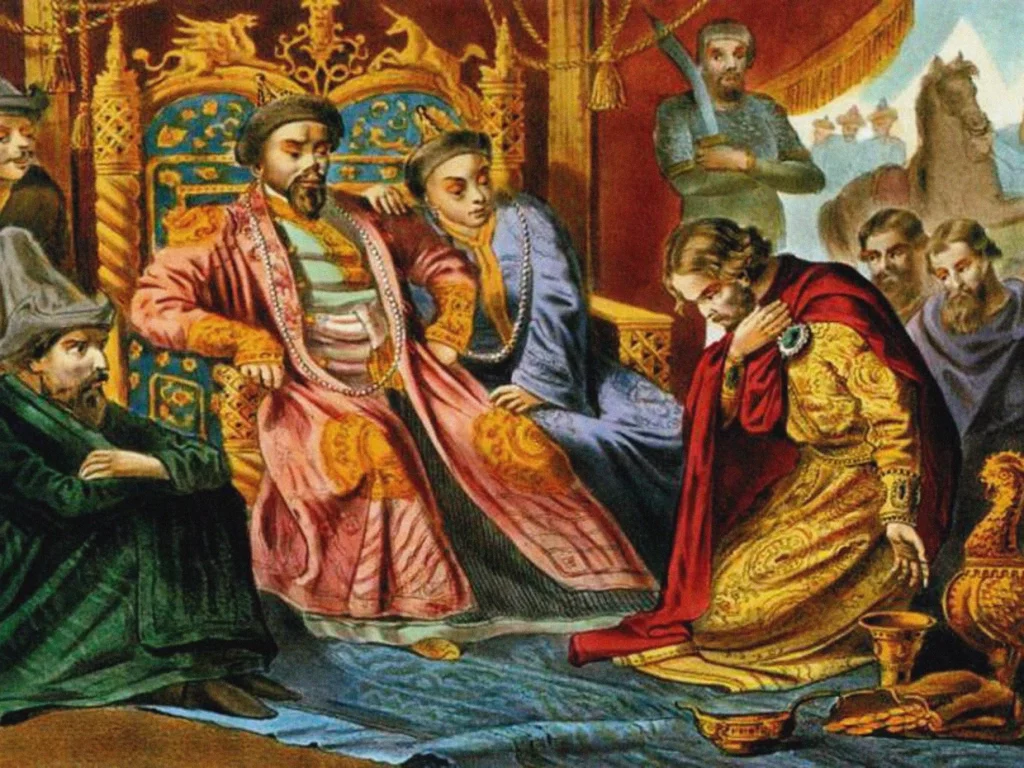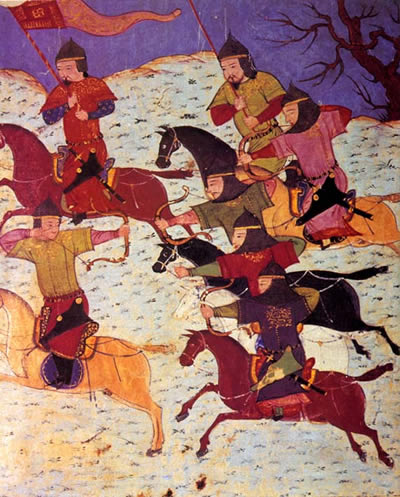Last updated on March 1st, 2023 at 04:52 pm
Genghis Khan was one of the most infamous and successful warriors in history. He was the founder and leader of the Mongol Empire, which controlled a large portion of Asia at its peak.
While many of us have heard bits and pieces about Genghis Khan and his crusades, in this guide, we’ll take a look at nine unbelievable stories about Genghis Khan. These stories paint a picture of a ruthless warrior who was not afraid to cut down any enemies or foes who got in his way.

The Time The Mongols Stacked Bones Into Piles the Size of Mountains
Back in the 12th Century, as the Mongols rampaged across the land, they didn’t just slay their enemies – they butchered them.
The Mongol warriors would take their prisoners and force them into a large pit. After everyone was crammed in, the Mongols would light the bottom of the pit on fire, roasting the prisoners alive.
In one gruesome incident, the Mongols used this method on over 500 Russian soldiers. The warriors were so proud of their handiwork that they built a pyramid out of the bodies and human bones.

Another story of these stacks of bones came from Ata-Malek Juyvanim, the court historian for Genghis Khan’s grandson.
In 1221, the Mongol army arrived in Merv, also known as the Merve Oasis or Alexandria, and attacked after scoping the place out for six days.
While the ransacking began, they said to the inhabitants of Merv they would be lenient if they surrendered, which they did. However, the Mongols didn’t keep to their word and massacred the entire city.
Genghis then sat on the golden throne within the oasis and ordered all captured troops to be brought to his feet, where they would be executed. The wealthiest of the cities reportedly suffered the most since they were tortured and beaten while their wealth was searched.
When all was done, Genghis Khan set the temple and tomb of Sultan Sanjar on fire and burned the city. After all, was said and done, as reported by Juyvanim, the corpses were stacked and piled high.
The number of people who perished was so many that “the bones of the slain formed mountains and the desert ran red with the blood of the dear ones.”
The Time He Staked the Heads of His Enemies
Genghis Khan was not a man to shy away from blood; he actually relished it. One of his favorite torture methods was “the thousand cuts.”
This method was exactly what it sounds like – the prisoner would be cut a thousand times until they bled out. This was a slow and painful way to go, precisely what Genghis Khan wanted.
In another story, Genghis Khan showed just how bloodthirsty he could be when he ordered the execution of 24,000 people in Herat in modern-day Afghanistan.
After the city had been conquered, he ordered that all the prisoners be brought to the central square.
Once there, the Mongolian soldiers began beheading them – but that wasn’t enough for the Khan. He wanted to ensure that everyone in the city got a good look at what happened to those who defied him, so he ordered that all of the heads be placed on stakes.
Absolute torture for all involved.
When He Destroyed an Empire for Harming a Messenger
In another story, Genghis Khan showed just how vengeful he could be. In 1219, a Mongolian messenger named Burcha was sent to the kingdom of Khwarezmia with a message for the king, Sultan Mahammad II.
When Burcha arrived carrying his messages of peace and trade, the king had him executed out of suspicion of not being after peace, and his head was sent back to Genghis Khan. He was so enraged by this act that he vowed to destroy the entire kingdom.
And that’s precisely what he did.

The Mongol armies ravaged the empire, conquering all Persian cities within the boundaries of the Khwarezm Empire, looting everything they could find, massacring everyone they came across, and razing the cities to dust.
It is estimated that over two million people were slaughtered during the invasion – all because a single messenger was slain.
The Time He Nearly Erased a City from the History Books
Back in 1208, Genghis was on his rampages across the Asian continent in search of wealth and power for his people, the Mongols and China at the time (and still a lot to this day) who had it. However, China was far too large for Genghis to conquer in one sweep, so he planned to chip away.
At the time, China was divided into three ruling empires. These were the Western Xia, Jin, and the Song. The Mongols first attacked the Western Xia, but their king surrendered and paid Genghis a hefty ransom to be spared.
Genghis then gave the empire a peace treaty that stated that as long as the Western Xia ruler stayed in his place, the Mongols would leave him and his people alone.
From here, Genghis moved forward with his assault on the Jin empire, but Jin wasn’t to be taken down so lightly, and the following fights would last up to five years.
During this time, specifically on an attack on Khwarezmia, a large area of land found between the Caspian and Aral seas, Genghis lost a large portion of his army to disease.
After this, as you can imagine, he was quite disgruntled.
He had lost a lot of men and was no closer to taking over China. So, he requested reinforcements from the previously conquered Xia empire. However, when Genghis requested reinforcements from the Xia empire, their ruler reneged on the deal, choosing instead to side with Jin.
And that’s when all hell broke loose.
Genghis Khan was so furious at the Xia ruler for breaking his word that he vowed to destroy the empire completely. The Mongols marched on Xi Xia just a year before Genghis passed away in 1227 and brutally attacked the empire.
Even after Genghis himself had passed, his troops continued to mercilessly and systematically plunder the empire until they surrendered once again.
Once surrendered, the Mongols slaughtered every inhabitant of the capital and destroyed the royal cemetery and related buildings. At this point, there was such little left of the cities that the civilization was almost lost in history.
That’s how brutally and abruptly the Mongols obliterated the city and its people.
The Mongols Executed Everyone Who Buried Genghis Khan
Perhaps one of the most elusive and mysterious Genghis Khan stories has to be this. After he passed away, he was buried in an unmarked grave.
According to legend, anyone who attempted to find his body and uncover his remains was slain. So, the location of Genghis Khan’s grave is still a mystery.
However, to confirm this was the case, stories state that the predecessors to Genghis Khan had anyone who was involved in burying him slaughtered. The official funeral happened in the Mongol capital of Karakorum, and anyone who attended was on the list.
This resulted in over 2,000 people who were at the funeral being executed by 800 soldiers, ensuring that the burial place would remain hidden forever.
Even today, while researchers say they have narrowed down the burial site to around the Burkhan Khaldun mountain area, the actual site has never been found.
The Time He Hired the Enemy
Rewind to the year 1201, Genghis Khan was battling his sworn rivals, the Taijut tribe, which could be found in present-day Russia. During the fight, an arrow sailed through the air, hitting Genghis Khan’s horse which caused him to be thrown to the ground.
After the battle was over and the Mongols had won, there are a few stories of what happened next.
One tells how after the fighting was over, Genghis Khan went through the prisoners of the Taijut methodically, questioning them to find the culprit. Another version states how the Taijut fled the battlefield, abandoning their posts to flee for their lives.
Whichever you choose to believe, both tales tell of the one man who stepped forward and took responsibility. He gave himself up, knowing that he would be executed by Genghis Khan.
However, Genghis Khan had other ideas. Instead of slaying the man, it turns out that Genghis Khan admired his boldness and courage for shooting and taking ownership and instead gave him a high-ranking position in his army.
Through irony, this man was given the nickname ‘Jebe,’ which quite literally means ‘arrow,’ and Jebe eventually became one of the Genghis’ highest-ranking generals.
The Punishment of God
Genghis Khan knew that he had a reputation, and the world knew it. After all, it’s a reputation that remains today.
Even at the time, Genghis knew what he was doing was operating on a god-like divine scale. After all, he was responsible for ending over 40 million lives.
Nevertheless, one story stands out that proves this point.
Knowing of Genghis wealth, he was pursued by merchants wherever he went, for he could afford the grandest things, yet one group of merchants seemed to go about it all wrong. They approached and sold him wares, but overcharged.
As you can imagine, he was outraged by the betrayal and plundered the merchants and everything they had.
However, to keep the peace between the Mongols and the Muslim nations and keep the trade routes alive, he decided to overpay and allow the merchants to continue what they were doing.
However, along the trade route, the merchants made it to Otrar, which is in Central Asia, and were arrested by the city. One of these merchants managed to avoid arrest and ran to Genghis Khan to tell him what happened.
Angered by what had happened, Genghis Khan ascended a mountain to ask for divine intervention to guide him as to what he should do next. Of course, he decided war was the option to go for, and so began a rampage toward the city.
He and the Mongols passed through pillaging and plundering every city they came across until they reached Bokhara. According to the scriptures, the fighting was so horrific that the desert sun reflected the pools of blood everywhere.
During this process, Genghis Khan said to the city leaders who had taken them as prisoners, “You have committed great sins. The great ones among you have committed these sins.
If you ask me what proof I have for these words, I say it is because I am the punishment of God. If you had not committed great sins, God would not have sent a punishment like me upon you.”
Genghis Khan Slew His Own Brother Over a Fish
Family matters, but this didn’t stop Genghis Khan when he had things to do. After the Tartars, an enemy tribe poisoned his father. The young Khan and the rest of his family were cast out by the tribal leaders, not giving him his rightful place as the heir.
Genghis Khan’s family endured hard times, scavenging and getting what they could to survive. On one of those days, he caught a fish that would provide food for the family, which was stolen by his half-brother, who it suggested didn’t want to share with the family.
And so, once an argument broke out, Genghis Khan slew his brother by waiting for him to be alone before shooting him with a single bow and arrow.
Marrying His Daughters Off for Control
While marrying people to help bring countries together is no new concept, Genghis Khan took it to another level. Of course, he was infamous for his strategic mind and epic political might, and with it, he was able to marry off his daughters to some of the kings of his allied nations.
However, there were terms. When a king was to marry one of Genghis Khan’s daughters, all other wives the king had to be relinquished, and while this might not seem bad, this was all to gain even more power.
He would send his sons-in-law to the front line of battle, where they would typically perish in the fighting, allowing him to drastically expand the reaches of the Mongol empires.
Unbelievable Tales of Genghis Khan
As you can see, Genghis Khan’s stories just become even more intense and unbelievable as you start to really dive into them and see what they’re all about and the actual details behind them.
Whether it’s his thirst for revenge, his political genius, or his utter ruthlessness, there’s no doubt that Genghis Khan was one of the most brutal, intense, and probably downright crazy leaders who have ever walked the face of this Earth.

